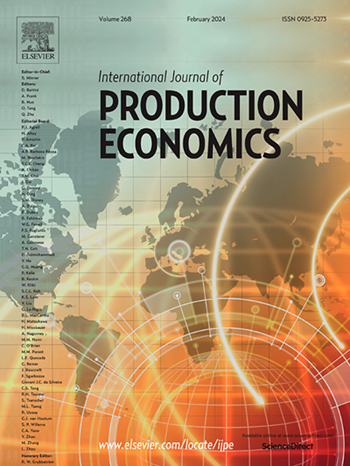智能生产线配置策略
IF 10
1区 工程技术
Q1 ENGINEERING, INDUSTRIAL
引用次数: 0
摘要
建立一条具有高柔性的智能生产线需要大量费用,因此在生产线配置中利用劳动力柔性的战略决策对智能工厂的成功至关重要。本研究考虑了多品种、小批量订单生产环境下的两种主流生产线配置策略:(1) 双线配置策略,即一条全自动智能生产线专注于生产相对标准化的产品,而一条人工生产线则致力于生产个性化产品。在这种策略下,我们获得了最优的工作分配。(2) 换线配置策略,即一条柔性生产线自动执行机器驱动的任务。只有在生产线转换和不同产品类型之间的设置时才需要人工干预。对这两种配置策略进行的成本比较分析表明,当生产批量超过一个批量阈值时,换线配置策略优于双线配置策略。此外,如果满足平方根规则,生产线转换策略始终优于双线策略。值得注意的是,对减少设置的投资有助于降低生产成本和减少批量临界值,从而扩大了生产线转换策略的优势。这两种配置策略的未来比较优势取决于当前的技术发展。本文章由计算机程序翻译,如有差异,请以英文原文为准。
The intelligent production line configuration strategy
Establishing an intelligent production line with high flexibility entails significant expenses, thereby strategic decision-making regarding the utilization of labor flexibility in the production line configuration becomes crucial for the success of a smart factory. This study considers two predominant production line configuration strategies in a production environment characterized by multi-variety and small-batch orders: (1) a double-line configuration strategy, where a fully automated intelligent production line focuses on producing relatively standardized products, while a manual production line is dedicated to crafting personalized products. We obtain optimal work allocation under this strategy. (2) a line-changeover configuration strategy, characterized by a single flexible production line where machine-driven tasks are automatically executed. Manual intervention is only required during line changeovers and setups between different product types. A comparative cost analysis between these two configuration strategies reveals that, for production batch size exceeding a batch threshold, the line-changeover strategy outperforms the double-line strategy. Moreover, if a square root rule is satisfied, the line-changeover strategy consistently outperforms the double-line strategy. Notably, investments directed towards setup reduction prove instrumental in reducing production costs and reducing the batch threshold, thereby amplifying the advantages of the line-changeover strategy. The future comparative advantage of these two configuration strategies is contingent upon ongoing technological developments.
求助全文
通过发布文献求助,成功后即可免费获取论文全文。
去求助
来源期刊
CiteScore
21.40
自引率
7.50%
发文量
266
审稿时长
52 days
期刊介绍:
The International Journal of Production Economics focuses on the interface between engineering and management. It covers all aspects of manufacturing and process industries, as well as production in general. The journal is interdisciplinary, considering activities throughout the product life cycle and material flow cycle. It aims to disseminate knowledge for improving industrial practice and strengthening the theoretical base for decision making. The journal serves as a forum for exchanging ideas and presenting new developments in theory and application, combining academic standards with practical value for industrial applications.

 求助内容:
求助内容: 应助结果提醒方式:
应助结果提醒方式:


